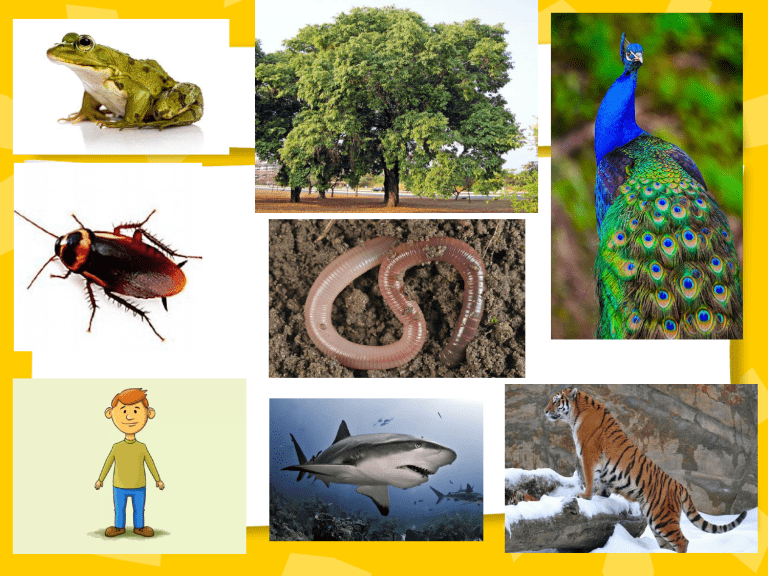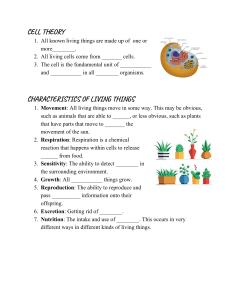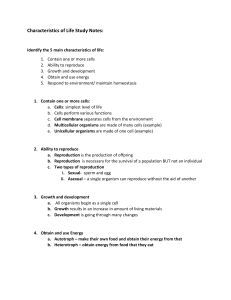
Characteristics of Living Things Grade 6 What is biology? The study of living things All living things share certain characteristics What is Living and What is Not??? Trying to determine if something is alive can be a little tricky. If you walk up and kick a tree trunk, nothing happens. No 'Ouch!' from the tree, and it won't run from you. A tree won't eat a cheeseburger out of your hand the way a dog might, or make waste that you have to clean up in the yard. Some living things appear to be non-moving and unresponsive to the environment at first glance. Scientists have come up with traits that all living things have in common. They help determine whether something is living or nonliving. 1. Made of 1 or more cells The first of these traits is that a living thing is made up of cells. A cell is the smallest unit of structure and function in something that lives. And even an organism made up of only one cell still meets the criteria for being a living thing. Cells are extremely tiny, and cannot be seen by the unaided human eye. Unicellular (one cell) - ex. Bacteria Multicellular (many cells) - ex. Animals, plants 2. Nutrition Second, organisms use energy and can get energy from a source. Living things use energy within their cells. This energy powers all kinds of processes, such as reproduction, growth, or body temperature regulation. Some living things take in nutrients, such as eating food or absorbing materials through roots or a cell membrane. Other living things get energy from the sun. The complex relationships between many organisms in an environment allow for energy to be passed between them. 2. Nutrition Autotrophs - get energy from sun Heterotrophs - get energy by consuming nutrients from their environment 3. Respiration All living things need energy. They get this energy from the food they eat. The process of getting energy from food is a chemical reaction called respiration. Respiration usually needs oxygen ( but it can happen without oxygen in some organisms). Food + Oxygen Carbon dioxide+ water + energy 4. Excretion Excretion means getting rid of the waste materials that can harm the body. Many of these waste products are made by chemical reactions that take place inside the body. If the waste products are not excreted, they build up in the body and they can cause the animal or the plant to die. 5. Movement The next trait is movement. Some organisms move in a very obvious way, such as a running animal or a sprouting seed. Other living things move in a way that is more difficult to detect. Technological devices, such as a microscope or camera, may be needed over a long period of time to be able to observe movement. 6. Respond to stimuli in their environment Stimuli - factors in the environment that living things react to (ex. Light, temperature, sound, etc.) 6. Respond to stimuli in their environment Living things respond and adapt to their environment. Many experiments have been done with plants to show how they grow towards light, also known as phototropism. This special ability allows the plant to maximize sunlight exposure necessary for growth. Other organisms have unique ways to handle extreme environments, like a leaf with a waxy cuticle that helps a plant retain water in the desert. Some responses are easy to observe, such as the pupil of an eye that constricts when a light is shone into it. 7. All living things reproduce Another characteristic of a living thing is reproduction. Reproduction is the passing on of genetic information to a new generation. You are probably familiar with how human and mammal reproduction works. It takes two to tango. Sexual reproduction is when DNA from two separate organisms combines to form a unique new individual. Some living things reproduce asexually, meaning they make an identical copy of their DNA, which carries genetic instructions that help create a new living form. Asexual reproduction could look like a single-celled organism splitting into two, or a mold sending spores out into the surrounding area. 7. All living things reproduce Sexual - two sex cells required (sperm and egg) Asexual - only one parent cell is needed 8. Grow and develop Living organisms also grow and develop. A baby develops in a mother's womb. At first, it looks like just a mass of cells, but over time the head, limbs, and specific organs form and grow. Likewise, a seed begins its life just under the soil and, over time, forms into a plant and grows up through the soil towards the sun. 8. Grow and develop Each cell divides to make new cells (cell division) – results in growth Some cells become specialized and perform different jobs than others (differentiation) 9. Maintain homeostasis Homeostasis – a relatively stable internal environment (within a certain range) - (ex. Human body temperature (approximately 98.6 degrees F)) 10. Have a universal genetic code All living things have DNA DNA passes on genetic information from one generation to the next For each behavior in the list below, write down one or more correct characteristics of living things from the box underneath. Smelling food Escaping from danger Producing fruit Hearing noise Giving birth to a baby Lifting a heavy object Chewing grass Getting taller Using oxygen to release energy Sweating Eating an apple Feeling tired because you have run fast Laying eggs Urinating Forming new plantlets Bending towards sunlight Nutrition respiration excretion reproduction sensitivity growth movement





